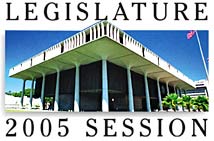Pay raises mean
no tax cuts
Talks are ongoing, but the state
expects to give public workers at
least a 1.5 percent pay increase
There will be no tax cuts this year, according to legislative leaders, because projected pay raises for state workers are likely to consume extra money in the budget.
|
|
Georgina Kawamura, state budget director, met with Senate leaders this week and told them that the extra costs of the annual raises would be $39.1 million for the first year and $83.8 million for the second year.
"Sometimes I think the only reason we meet here (the state Capitol) is to crown beauty queens and pay off the public employees," Sen. Sam Slom (R, Diamond Head-Hawaii Kai) complained.
The new figures doom any tax breaks for this year.
Senate President Robert Bunda, sponsor of one plan to reduce state income taxes, said his plan can be considered in 2006, but it is dead for this legislative session.
"It now seems clear that the administration is bargaining for something that is going to put us in the red," Bunda said.
State officials insist the budget will not go into a deficit. Even if the raises were applied to all the state unions now negotiating, the state could afford them, Kawamura said.
"There is some concern about the total amount, but that (a 1.5 percent per year raise) is the best we can hope for. It is doable," Kawamura said.
The budgets and the new state contracts start July 1, the beginning of the state's fiscal year.
The 1.5 percent figure was used as a basis for the other units also negotiating, including the Hawaii State Teachers Association, the United Public Workers and the state's largest union, the Hawaii Government Employees Association.
But the pay raises could go much higher.
The HGEA, for instance, negotiates differently from the other unions because of binding arbitration.
Under binding arbitration, the state and the union present their case for pay raises to a three-person panel, made up of one union representative, one from management and one professional arbitrator.
The HGEA case was heard last month and the arbitrator has until April 15 to come back with a pay-raise plan. In the past, the arbitrator's awards have generally been higher than the state's last offer.
Between now and April 15, the state and the HGEA can reach their own agreement. Observers say if a compromise is reached, it also is likely to be more than the state's offer of 1.5 percent.
"Right now the teachers are asking 15 percent a year for two years, the HGEA offer is more like 5 and 7 percent, and UPW is waiting to see what everyone else gets," said Sen. Brian Taniguchi, Senate Ways and Means Committee chairman.
"This means we are going to have to ratchet down our assumptions, we will have to eliminate tax credits ... and we are going to be more aggressive in trimming the governor's budget," Taniguchi said.
The state Council on Revenues, which sets the estimated amount of money the state can expect to collect from taxes and fees, figures the state will get an extra $75 million this year, but that the expanding economy will not continue and projected revenues in the future will decline by $270 million by fiscal year 2008.
That has both Republican and Democratic legislators concerned.
"We have more money in the budget than first anticipated, which is a good thing, but we also have more demands and we can expect higher amounts from binding arbitration than we can afford," Slom said.
Bunda said: "We need to study or at least be more definitive by the end of the session on what is happening between the administration and all the (labor) units. We have an idea that the governor's budget is not balancing because of collective bargaining."
Randy Perreira, HGEA deputy executive director, said both the state and his union had submitted complicated wage packages to arbitration. Perreira said that with step increases factored in, the union is asking for increases ranging from between 10 percent and 14 percent for the different bargaining units covered by the HGEA.
The state's offer was for 1.5 percent increases each year, with some employees in hard-to-attract categories such as medicine getting 4 percent increases.
Lingle this year said the state approached bargaining with the HGEA differently.
"We hired outside experts to help make our case," Lingle said. "I think in the end it will make an important difference."
In past bargaining sessions, Lingle said, the HGEA had hired economic experts while the state had relied on state workers who had other jobs besides testifying in two-week-long arbitration cases.
"I don't think the cases were being presented as well and that we were doing as good a job in cross-examining their expert witnesses," Lingle said.
"This time, we hired national experts and they did a wage analysis," she said.
Talks with other unions, including the teachers and blue-collar workers, are not as far along as the HGEA negotiators, Lingle said.
Perreira agreed that the state was able to present a better case than in previous bargaining sessions, but discounted the overall impact of the state presentation.
"The guy that showed up for the state was a bright guy, but I think they overpaid," Perreira said. "They came better prepared and we are still hopeful that the governor and the county mayors will be willing to negotiate with us and resolve this without waiting for the arbitrator's decision."
[News] [Business] [Features] [Sports] [Editorial] [Do It Electric!]
[Classified Ads] [Search] [Subscribe] [Info] [Letter to Editor]
[Feedback]

